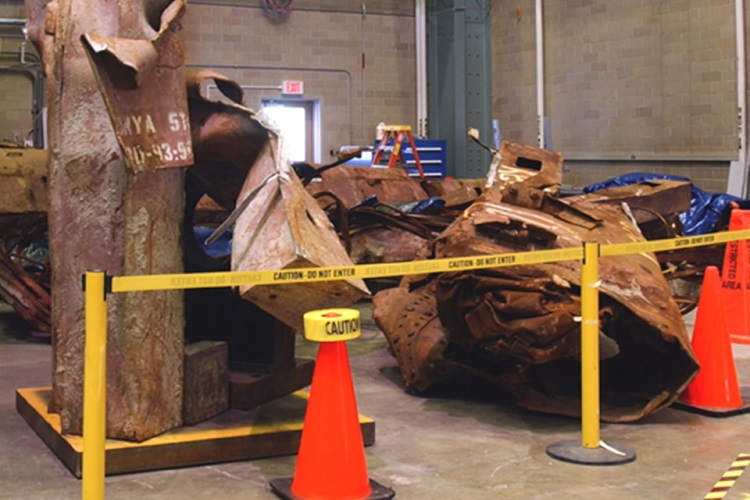
By Gregory Havel
September 11, 2016, marked the 15th anniversary of the terrorist attacks on the United States. These included a plane that was deliberately flown at cruising speed into the Pentagon in Arlington, Virginia; the failed attack that ended with a plane crash in Shanksville, Pennsylvania; and the two planes that were deliberately flown at cruising speed into the World Trade Center’s Twin Towers in Manhattan in New York City.
The impact on American society, including the loss of thousands of civilian lives; the personal sacrifice by hundreds of fire, emergency medical service, and law enforcement officers; and the new understanding that “it CAN happen here” was so great that its effects are still felt today. Besides our annual commemoration of these events, we owe those who lost their lives on that day an ongoing discussion of how and why these events happened and what we can do to prevent recurrences in the future.
The World Trade Center’s Twin Towers were designed by professional architects and engineers to withstand hurricane-force winds as well as the impact of a Boeing 707 airliner flying at landing approach speeds (usually less than 200 miles per hour). These criteria were based on calculations of the actual impact of a B-25 bomber that was preparing to land at the Newark (NJ) International Airport on Saturday, morning July 28, 1945, but whose pilot became disoriented in fog and crashed into the Empire State Building’s north wall at the 79th floor. This plane crash caused fires on multiple floors of the building, which took some hours to control. However, the structural damage was not severe because of the mass of the structure, whose structural steel frame was protected by masonry and concrete and which was repaired while the rest of the building remained occupied.
RELATED: Gagliano on 9/11 at Disneyland ‖ Eversburg on the Pentagon Attack ‖ Collins on Rescue and Terrorism
The planes flown by the hijacker-terrorists into the World Trade Center were Boeing 767 commercial jetliners, resulting in impact forces many times greater than either the World Trade Center’s impact design load or the actual impact of the B-25 on the Empire State Building. A comparison of the three airplanes follows:
- A B-25 bomber is powered by two 14-cylinder air-cooled radial engines. A Boeing 707 is powered by four jet engines. A Boeing 767 is powered by two jet engines that develop twice the thrust of the four engines of the 707.
- A B-25 bomber is 53 feet long (16.15 m), with a wingspan of 67.3 feet (20.6 m). A Boeing 707 is 136 feet long (41.25 m) with a wingspan of 131 feet (39.9 m). A Boeing 767 is 201 feet long with a wingspan of 171 feet.
- A B-25 bomber weighs 19,500 pounds (8,855 kg) empty and has a maximum takeoff weight of 35,000 pounds (15,910 kg). A Boeing 707 weighs 103,145 pounds (55,580 kg) empty and has a maximum takeoff weight of 222,000 pounds (100,800 kg). A Boeing 767 weighs 229,000 empty and has a maximum takeoff weight of 450,000 pounds.
- A Boeing 767 has a fuel capacity of 24,140 gallons (91,000 l), more than double the capacity of a Boeing 707, and more than five times the capacity of a B-25 bomber.
- A B-25 bomber cruises at 230 miles per hour (mph) (370 km/hour) and has a landing approach speed of less than 100 mph. The cruising speed of the Boeing 707 and 767 planes is 570 mph (851 km/h).
The planes that struck the World Trade Center Twin Towers weighed 100-percent more, carried 100-percent more fuel, and were moving more than 100-percent faster than the planes whose impact the buildings were designed to withstand. The structural steel at the point of impact by the planes was punctured and shredded. In photo 1, the numbers along the left margin indicate floor levels, while the numbers along the top margin indicate column lines on the building’s structural plans.
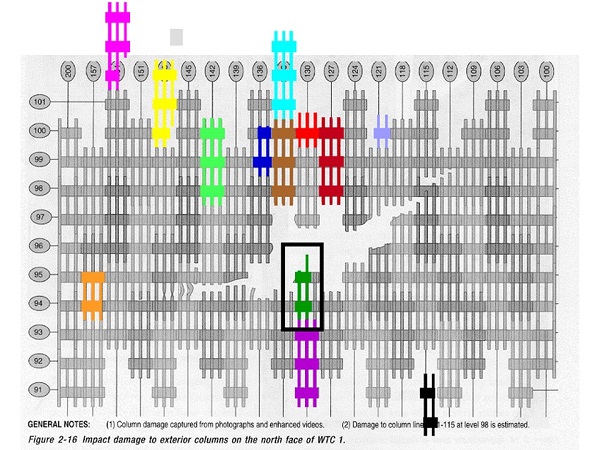
(1) Courtesy of the National Institute of Standards and Technology (NIST) 9/11 reports.
Photo 2 shows a sample floor layout on the left, including the central core of the building containing utility chases, stairways, and elevators; and the arrangement of express and local elevators serving groups of floor at the right.
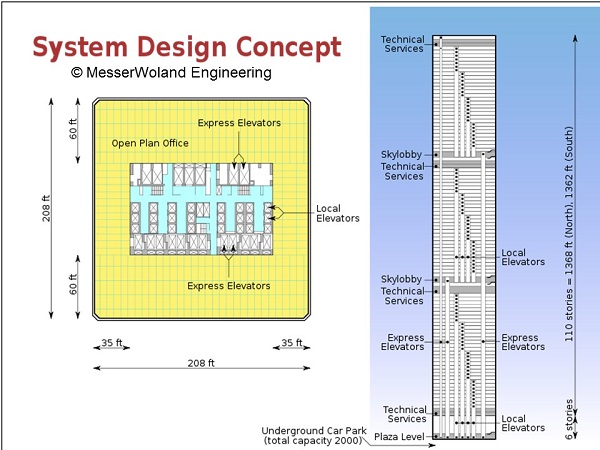
(2) Courtesy of NIST 9/11 reports.
Note that although the exterior skin of the building was of structural steel panels and columns that were bolted together, all of the interior partitions were steel stud and gypsum drywall board or thicker gypsum board panels enclosing stairways and elevator hoistways. Gypsum drywall board provides significant fire resistance provided that it is not subjected to mechanical damage before the fire starts. Also note that the floors were of concrete poured on corrugated steel sheets supported by steel bar joists which had been sprayed with fire-resistive insulation similar to that in photo 3. This material provides significant fire resistance, provided that it has not been removed, fallen off, or destroyed by an impact before the fire starts.
(3) Photo by author.
The fireball created by the ignited jet fuel softened and weakened undamaged structural steel and, combined with the forces of the collapsing structures, pressed and twisted it into unrecognizable shapes. In photo 4, the stenciled letters and numbers refer to the column line and floor number for which that structural member was fabricated.
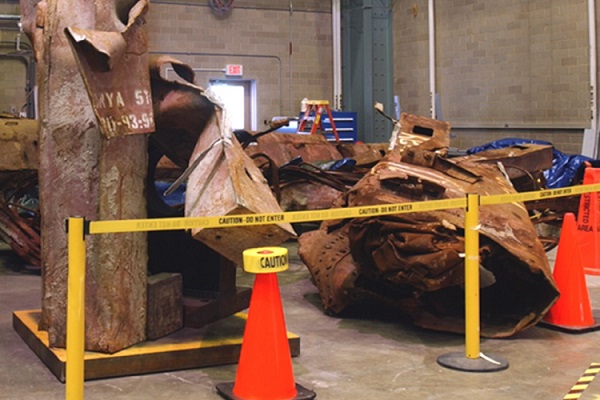
(4) Courtesy of NIST 9/11 reports.
The impacted buildings were designed using proven principles and connection methods, including the concept of axial loading of columns (the load on the column is carried directly downward from the load through the axis—or center—of a column or load-bearing wall to its foundations and the earth below) and the simple bolted connections of each floor truss to a girder, wall channel, or column. Photo 5 shows the standard two-bolt connection between columns, girders, and bar joists, which has been in use since riveted connections were replaced by bolts, through to the construction of the World Trade Center complex, and into present day. New buildings with structural steel frames, both low- and high-rise, are still being designed with these connections.
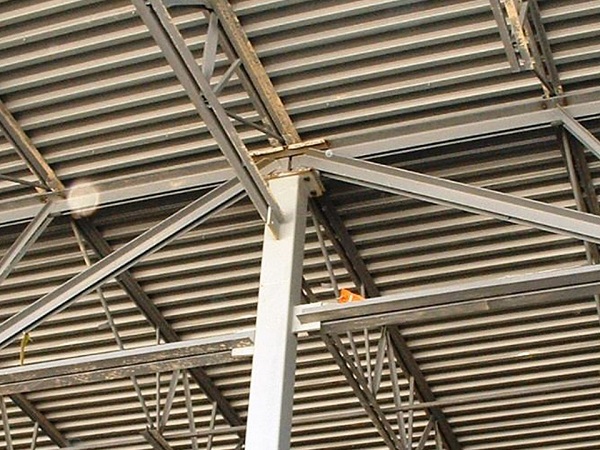
(5) Photo by author.
Even the Pentagon, which was massively built of reinforced concrete, sustained serious damage to part of the building from a similar impact, and fires that required several days to control.
Some questions raised by the World Trade Center terrorist attack and the collapsed structures have no definitive answers even after analysis and reconstruction of the incident, such as the following:
- How many floor trusses were destroyed or displaced by the planes’ impact?
- How many floor trusses failed because of exposure to fire?
- How much of the fireproofing insulation was already missing before September 11, 2001?
- How much of the fireproofing insulation was dislodged by the planes’ impacts?
- How many center core columns were damaged or destroyed before the structural collapse?
- Which damaged structural elements (floors, perimeter columns, center core columns) were the primary players in the structural collapse, and which were secondary?
Other questions remain under discussion, with no clear conclusion even after 15 years, including the following:
- Should lightweight trusses be used in high-rise buildings in the future?
- Should spray-on fireproofing be inspected more closely, including before, during, and after application?
- Should spray-on fireproofing be made more resistant to mechanical damage?
- Should any buildings be exempt from state and local building and fire codes as was the World Trade Center complex?
- What role should the fire department play in the design, construction, and inspection of new and existing buildings?
- What role should the fire service play in the development of future building and fire codes and the education of architects, engineers, and code developers on fire protection principles?
For more information on these events and the reconstruction of the incidents and structural collapse, internet search for “World Trade Center Collapse” and “9-11-2001.”
To view the reports from the National Institute for Standards and Technology, visit https://www.nist.gov/engineering-laboratory/final-reports-nist-world-trade-center-disaster-investigation.
Besides our annual commemoration of these events, we owe those who lost their lives on that day an ongoing discussion of how and why these events happened and what we can do to prevent recurrences in the future, including promoting changes in building design for occupant safety.
We must not be complacent and assume that, like lightning, since we have been struck once, we will not be struck again. Lightning does strike more than once in the same location, and terrorists can and probably will bring their wars to us in our homes.
Download this article as a PDF HERE (488 KB)
 Gregory Havel is a member of the Town of Burlington (WI) Fire Department; retired deputy chief and training officer; and a 35-year veteran of the fire service. He is a Wisconsin-certified fire instructor II, fire officer II, and fire inspector; an adjunct instructor in fire service programs at Gateway Technical College; and safety director for Scherrer Construction Co., Inc. Havel has a bachelor’s degree from St. Norbert College; has more than 35 years of experience in facilities management and building construction; and has presented classes at FDIC.
Gregory Havel is a member of the Town of Burlington (WI) Fire Department; retired deputy chief and training officer; and a 35-year veteran of the fire service. He is a Wisconsin-certified fire instructor II, fire officer II, and fire inspector; an adjunct instructor in fire service programs at Gateway Technical College; and safety director for Scherrer Construction Co., Inc. Havel has a bachelor’s degree from St. Norbert College; has more than 35 years of experience in facilities management and building construction; and has presented classes at FDIC.
MORE CONSTRUCTION CONCERNS

